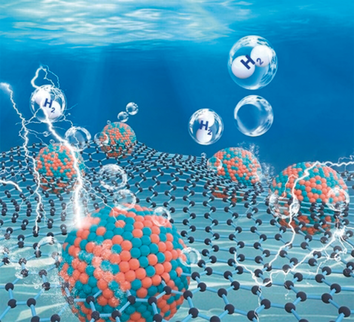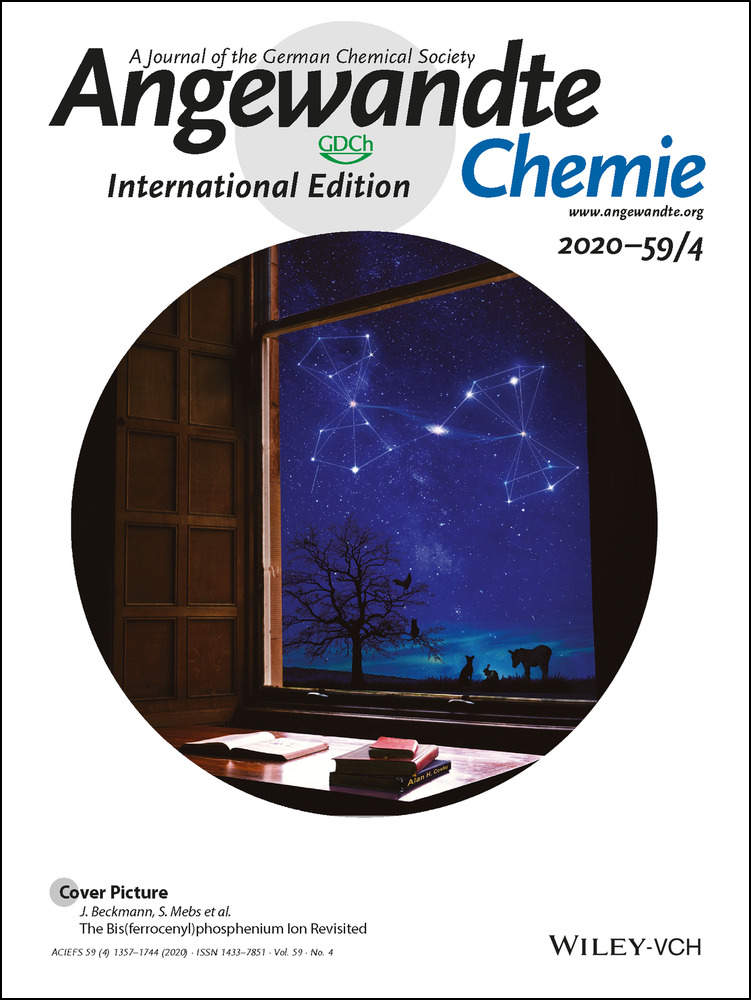A General Route to Prepare Low-Ruthenium-Content Bimetallic Electrocatalysts for pH-Universal Hydrogen Evolution Reaction by Using Carbon Quantum Dots
Yuan Liu
College of Chemistry, College of Materials Science and Engineering, Zhengzhou University, Zhengzhou, 450000 China
These authors contributed equally to this work.
Search for more papers by this authorXue Li
College of Physics, Jilin University, Jilin, 130012 China
These authors contributed equally to this work.
Search for more papers by this authorDr. Qinghua Zhang
Beijing National Laboratory for Condensed Matter Physics, Institute of Physics, Chinese Academy of Sciences, Beijing, 100190 China
These authors contributed equally to this work.
Search for more papers by this authorWeidong Li
College of Chemistry, College of Materials Science and Engineering, Zhengzhou University, Zhengzhou, 450000 China
Search for more papers by this authorProf. Yu Xie
College of Physics, Jilin University, Jilin, 130012 China
Search for more papers by this authorProf. Hanyu Liu
College of Physics, Jilin University, Jilin, 130012 China
Search for more papers by this authorDr. Lu Shang
Key Laboratory of Photochemical Conversion and Optoelectronic Materials, Technical Institute of Physics and Chemistry, Chinese Academy of Sciences, Beijing, 100190 China
Search for more papers by this authorProf. Zhongyi Liu
College of Chemistry, College of Materials Science and Engineering, Zhengzhou University, Zhengzhou, 450000 China
Search for more papers by this authorProf. Zhimin Chen
College of Chemistry, College of Materials Science and Engineering, Zhengzhou University, Zhengzhou, 450000 China
Search for more papers by this authorProf. Lin Gu
Beijing National Laboratory for Condensed Matter Physics, Institute of Physics, Chinese Academy of Sciences, Beijing, 100190 China
Search for more papers by this authorProf. Zhiyong Tang
Henan Institute of Advanced Technology, Zhengzhou University, Zhengzhou, 450000 China
Search for more papers by this authorCorresponding Author
Prof. Tierui Zhang
Key Laboratory of Photochemical Conversion and Optoelectronic Materials, Technical Institute of Physics and Chemistry, Chinese Academy of Sciences, Beijing, 100190 China
Search for more papers by this authorCorresponding Author
Prof. Siyu Lu
College of Chemistry, College of Materials Science and Engineering, Zhengzhou University, Zhengzhou, 450000 China
Search for more papers by this authorYuan Liu
College of Chemistry, College of Materials Science and Engineering, Zhengzhou University, Zhengzhou, 450000 China
These authors contributed equally to this work.
Search for more papers by this authorXue Li
College of Physics, Jilin University, Jilin, 130012 China
These authors contributed equally to this work.
Search for more papers by this authorDr. Qinghua Zhang
Beijing National Laboratory for Condensed Matter Physics, Institute of Physics, Chinese Academy of Sciences, Beijing, 100190 China
These authors contributed equally to this work.
Search for more papers by this authorWeidong Li
College of Chemistry, College of Materials Science and Engineering, Zhengzhou University, Zhengzhou, 450000 China
Search for more papers by this authorProf. Yu Xie
College of Physics, Jilin University, Jilin, 130012 China
Search for more papers by this authorProf. Hanyu Liu
College of Physics, Jilin University, Jilin, 130012 China
Search for more papers by this authorDr. Lu Shang
Key Laboratory of Photochemical Conversion and Optoelectronic Materials, Technical Institute of Physics and Chemistry, Chinese Academy of Sciences, Beijing, 100190 China
Search for more papers by this authorProf. Zhongyi Liu
College of Chemistry, College of Materials Science and Engineering, Zhengzhou University, Zhengzhou, 450000 China
Search for more papers by this authorProf. Zhimin Chen
College of Chemistry, College of Materials Science and Engineering, Zhengzhou University, Zhengzhou, 450000 China
Search for more papers by this authorProf. Lin Gu
Beijing National Laboratory for Condensed Matter Physics, Institute of Physics, Chinese Academy of Sciences, Beijing, 100190 China
Search for more papers by this authorProf. Zhiyong Tang
Henan Institute of Advanced Technology, Zhengzhou University, Zhengzhou, 450000 China
Search for more papers by this authorCorresponding Author
Prof. Tierui Zhang
Key Laboratory of Photochemical Conversion and Optoelectronic Materials, Technical Institute of Physics and Chemistry, Chinese Academy of Sciences, Beijing, 100190 China
Search for more papers by this authorCorresponding Author
Prof. Siyu Lu
College of Chemistry, College of Materials Science and Engineering, Zhengzhou University, Zhengzhou, 450000 China
Search for more papers by this authorGraphical Abstract
How low can Ru go: A scalable and general synthetic method for the preparation of transition-metal-doped RuM/carbon quantum dots (CQDs; M=Ni, Mn, Cu) has been developed through metal-mediated CQD condensation and carbonization. The low-ruthenium-content RuM/CQD catalysts exhibit outstanding activity and stability in catalyzing hydrogen evolution at all pH values.
Abstract
A challenging but pressing task to design and synthesize novel, efficient, and robust pH-universal hydrogen evolution reaction (HER) electrocatalysts for scalable and sustainable hydrogen production through electrochemical water splitting. Herein, we report a facile method to prepare an efficient and robust Ru-M (M=Ni, Mn, Cu) bimetal nanoparticle and carbon quantum dot hybrid (RuM/CQDs) for pH-universal HER. The RuNi/CQDs catalysts exhibit outstanding HER performance at all pH levels. The unexpected low overpotentials of 13, 58, and 18 mV shown by RuNi/CQDs allow a current density of 10 mA cm−2 in 1 m KOH, 0.5 m H2SO4, and 1 m PBS, respectively, for Ru loading at 5.93 μgRu cm−2. This performance is among the best catalytic activities reported for any platinum-free electrocatalyst. Theoretical studies reveal that Ni doping results in a moderate weakening of the hydrogen bonding energy of nearby surface Ru atoms, which plays a critical role in improving the HER activity.
Conflict of interest
The authors declare no conflict of interest.
Supporting Information
As a service to our authors and readers, this journal provides supporting information supplied by the authors. Such materials are peer reviewed and may be re-organized for online delivery, but are not copy-edited or typeset. Technical support issues arising from supporting information (other than missing files) should be addressed to the authors.
| Filename | Description |
|---|---|
| anie201913910-sup-0001-misc_information.pdf1.6 MB | Supplementary |
Please note: The publisher is not responsible for the content or functionality of any supporting information supplied by the authors. Any queries (other than missing content) should be directed to the corresponding author for the article.
References
- 1I. Staffell, D. Scamman, A. V. Abad, P. Balcombe, P. E. Doods, P. Ekins, N. Shah, K. R. Ward, Energy Environ. Sci. 2019, 12, 463–491.
- 2C. Wei, R. R. Rao, J. Peng, B. Huang, I. E. L. Stephens, M. Risch, Z. Xu, Y. S. Horn, Adv. Mater. 2019, 31, 1806296.
- 3C. Jiang, J. Ma, G. Corre, S. L. Jain, J. T. S. Irvine, Chem. Soc. Rev. 2017, 46, 2889–2912.
- 4D. K. Lee, K. S. Choi, Nat. Energy 2018, 3, 53–60.
- 5P. Munnik, P. E. de Jongh, K. P. de Jong, Chem. Rev. 2015, 115, 6687–6718.
- 6J. Liu, D. Zhu, Y. Zheng, A. Vasileff, S. Z. Qiao, ACS Catal. 2018, 8, 6707–6732.
- 7S. Y. Nong, W. J. Dong, J. W. Yin, B. W. Dong, Y. Lu, X. T. Yuan, X. Wang, F. Q. Huang, J. Am. Chem. Soc. 2018, 140, 5719–5727.
- 8L. Yang, W. Zhou, J. Lu, D. Hou, Y. Ke, G. Li, Z. Tang, X. Kang, S. Chen, Nano Energy 2016, 22, 490–498.
- 9G. Zhang, H. Liu, J. Qu, J. Li, Energy Environ. Sci. 2016, 9, 1190–1209.
- 10X. Hai, W. Zhou, S. Wang, H. Pang, K. Chang, F. Ichihara, J. Ye, Nano Energy 2017, 39, 409–417.
- 11X. Ma, K. Li, X. Zhang, B. Wei, H. Yang, L. Liu, M. Zhang, X. Zhang, Y. Chen, J. Mater. Chem. A 2019, 7, 14904–14915.
- 12W. Zhou, T. Xiong, C. Shi, J. Zhou, K. Zhou, N. Zhu, L. Li, Z. Tang, S. Chen, Angew. Chem. Int. Ed. 2016, 55, 8416–8420; Angew. Chem. 2016, 128, 8556–8560.
- 13Z. F. Huang, J. Song, K. Li, M. Tahir, Y. T. Wang, L. Pan, L. Wang, X. Zhang, J. Zou, J. Am. Chem. Soc. 2016, 138, 1359–1365.
- 14S. Wang, J. Wang, M. Zhu, X. Bao, B. Xiao, D. Su, H. Li, Y. Wang, J. Am. Chem. Soc. 2015, 137, 15753–15759.
- 15Y. Liu, X. Yong, Z. Liu, Z. Chen, Z. Kang, S. Lu, Adv. Sustainable Syst. 2019, 3, 1800161.
- 16L. Huang, X. Zhang, Q. Wang, Y. Han, Y. Fang, S. Dong, J. Am. Chem. Soc. 2018, 140, 1142–1147.
- 17Z. Geng, Y. Liu, X. Kong, P. Li, K. Li, Z. Liu, J. Du, M. Shu, R. Si, J. Zeng, Adv. Mater. 2018, 30, 1803498.
- 18F. Xu, Y. J. Li, C. Huang, H. C. Xu, ACS Catal. 2018, 8, 3820–3824.
- 19C. Zhang, Y. Liu, Y. Chang, Y. Lu, S. Zhao, D. Xu, Z. Dai, M. Han, J. Bao, ACS Appl. Mater. Interfaces 2017, 9, 17326–17336.
- 20J. Mao, C. T. He, J. Pei, W. Chen, D. He, Y. He, Z. Zhuang, C. Chen, Q. Peng, D. Wang, Y. Li, Nat. Commun. 2018, 9, 4958.
- 21J. Su, Y. Yang, G. Xia, J. Chen, P. Jiang, Q. Chen, Nat. Commun. 2017, 8, 16029.
- 22C. Panda, P. W. Menezes, S. Yao, J. Schmidt, C. Walter, J. N. Hausmann, M. Driess, J. Am. Chem. Soc. 2019, 141, 13306–13310.
- 23Q. Yao, B. Huang, N. Zhang, M. Sun, Q. Shao, X. Huang, Angew. Chem. Int. Ed. 2019, 58, 13983–13988; Angew. Chem. 2019, 131, 14121–14126.
- 24Q. Feng, S. Zhao, Q. Xu, W. Chen, S. Tian, Y. Wang, W. Yan, J. Luo, D. Wang, Y. Li, Adv. Mater. 2019, 31, 1901024.
- 25J. C. Li, F. Xiao, H. Zhong, T. Li, M. Xu, L. Ma, M. Cheng, D. Liu, S. Feng, Q. Shi, H. M. Cheng, C. Liu, D. Du, S. P. Beckman, X. Pan, Y. Lin, M. Shao, ACS Catal. 2019, 9, 5929–5934.
- 26Z. W. Seh, J. Kibsgaard, C. F. Dickens, I. Chorkendorff, J. K. Nørskov, T. F. Jaramillo, Science 2017, 355, eaad 4998.
- 27S. Lu, G. Xiao, L. Sui, T. Feng, X. Yong, S. Zhu, B. Li, Z. Liu, B. Zou, M. Jin, J. S. Tse, H. Yan, B. Yang, Angew. Chem. Int. Ed. 2017, 56, 6187–6191; Angew. Chem. 2017, 129, 6283–6287.
- 28S. Lu, L. Sui, S. Zhu, A. Chen, M. Jin, B. Yang, Adv. Mater. 2017, 29, 1603443.
- 29B. Kong, J. Tang, Y. Zhang, T. Jiang, X. Gong, C. Peng, J. Wei, J. Yang, Y. Wang, X. Wang, G. Zheng, C. Selomulya, D. Y. Zhao, Nat. Chem. 2016, 8, 171–178.
- 30W. Li, Y. Liu, B. Wang, H. Song, Z. Liu, S. Lu, B. Yang, Chin. Chem. Lett. 2019, https://doi.org/10.1016/j.cclet.2019.06.040.
- 31B. Wang, J. Li, Z. Tang, B. Yang, S. Lu, Sci. Bull. 2019, 64, 1285–1292.
- 32J. Zhang, S. H. Yu, Mater. Today 2016, 19, 382–393.
- 33W. Li, Y. Liu, M. Wu, X. Feng, S. A. T. Redfern, Y. Shang, X. Yong, T. Feng, K. Wu, Z. Liu, B. Li, Z. Chen, J. S. Tse, S. Lu, B. Yang, Adv. Mater. 2018, 30, 1800676.
- 34Y. Liu, Y. Yang, Z. Peng, Z. Liu, Z. Chen, L. Shang, S. Lu, T. Zhang, Nano Energy 2019, https://doi.org/10.1016/j.nanoen.2019.104023.
- 35H. Yu, R. Shi, Y. Zhao, G. I. N. Waterhouse, L. Z. Wu, C. H. Tung, T. Zhang, Adv. Mater. 2016, 28, 9454–9477.
- 36C. Zhu, Y. Fu, C. Liu, Y. Liu, L. Hu, J. Liu, I. Bello, H. Li, N. Liu, S. Guo, H. Huang, Y. Lifshitz, S.-T. Lee, Z. Kang, Adv. Mater. 2017, 29, 1701399.
- 37S. Zhang, J. Zhu, Y. Qing, L. Wang, J. Zhao, J. Liu, W. Tian, D. Jia, Z. Fan, Adv. Funct. Mater. 2018, 28, 1805898.
- 38S. Zhu, Q. Meng, L. Wang, J. Zhang, Y. Song, H. Jin, K. Zhang, H. Sun, H. Wang, B. Yang, Angew. Chem. Int. Ed. 2013, 52, 3953–3957; Angew. Chem. 2013, 125, 4045–4049.
- 39Y. Dai, H. Jiang, Y. Hu, Y. Fu, C. Li, Ind. Eng. Chem. Res. 2014, 53, 3125–3130.
- 40J. Wang, Z. Wei, S. Mao, H. Li, Y. Wang, Energy Environ. Sci. 2018, 11, 800–806.
- 41Z. Pu, I. S. Amiinu, Z. Kou, W. Li, S. Mu, Angew. Chem. Int. Ed. 2017, 56, 11559–11564; Angew. Chem. 2017, 129, 11717–11722.
- 42J. Mahmood, F. Li, S. M. Jung, M. S. Okyay, I. Ahmad, S. J. Kim, N. Park, H. Y. Jeong, J. B. Baek, Nat. Nanotechnol. 2017, 12, 441–446.





